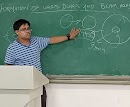Astronomy and Astrophysics
A Crisped Analysis of Nucleosynthesis phase after Big Bang!!!
Nucleosynthesis phase is the 8th phase according to the Chronology of the Universe.
It’s the very next step of Lepton Epoch. Lepton Epoch was started approximately
around 3 minutes after Big Bang and lasted up to 20 minutes after the big bang.
If you haven’t
read my article on Lepton Epoch then, I suggest you to read that first as it
will help you understand this article fully…..
During this phase,
nuclei of lightest elements like Hydrogen-1(the lightest isotope of Hydrogen)
started to form. This phase is also responsible for the creation of other light
elements like helium isotopes: Helium-3 and Helium-4, hydrogen isotope:
Deuterium and lithium isotope: Lithium-7.
 |
| Hydrogen-1 (the lightest isotope of hydrogen) |
Deuterium atoms were
produced by the collision of protons and neutrons (one proton bound to one
neutron). Then, most of the Deuterium atoms collided other protons and neutrons
to produce helium and tritium which is made up of one proton and two neutrons.
Similarly, Lithium-7 atoms were also created by the collision of one tritium
and two deuterium nuclei.
 |
| Helium 3 (left) and Helium 4 (Right) |
After several years of extensive research, astronomers also found that along with all these stable nuclei, this phase created some other particles also which are unstable in nature, like heavy hydrogen isotope tritium and beryllium isotope beryllium-7. These isotopes have a nature to decay into helium-3 and lithium-7.
 |
| Lithium -7 |
All the heavier elements were created later by a process called stellar nucleosynthesis in which all the heavier elements are created inside the stars by nuclear fusion reactions.
During this time
frame, the temperature of the universe dropped from 10^32 Kelvin to
approximately 10^9 Kelvin and thus created a suitable environment for the
creation of nuclei.
Prediction and
Measurement of particles
The Nucleosynthesis
theory predicts that roughly 25% of the visible mass of the Universe consists of Helium and
also, 0.01% of deuterium is also present.
Also, the present
measurements of Helium-3 and Helium-4 indicate good agreement with the theoretical
and experimental values. But, in the case of lithium -7, there is a
significant discrepancy between this theory and the experimental results of
WMAP/Plank probes. The experimental values are lower than the theoretical values
by the factor of 2.4-4.3 and this resulted in the revised
calculations of this theory.
In my next article, I am going to write about the Photon Epoch which is the next step after the Nucleosynthesis phase. So, don't forget to check that out. Once it is uploaded, link will be available here......
In my next article, I am going to write about the Photon Epoch which is the next step after the Nucleosynthesis phase. So, don't forget to check that out. Once it is uploaded, link will be available here......
To know basics of the quantum world, astronomy and space exploration you can check out my book "Through the wormhole" on amazon kindle.
You can directly talk with me on Instagram
To meet more physics Enthusiasts please join our Facebook Page
Also for the latest updates of my posts join me on TwitterTo meet more physics Enthusiasts please join our Facebook Page
Thanks for reading.....
See you next time!!!
-Ratnadeep Das Choudhury
Founder and Writer of The Dynamic Frequency













0 Comments